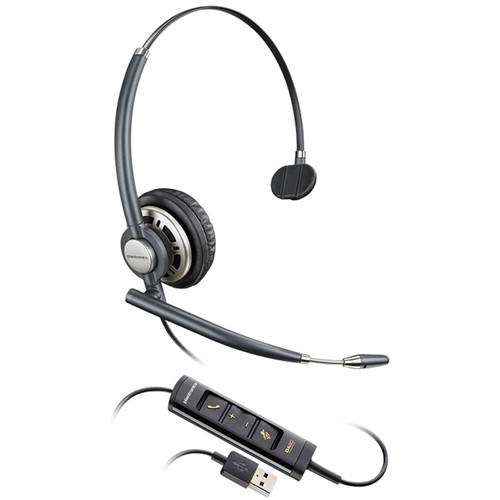
- #Plantronics Usb Headset Not Detected Mac OS Sound#
- #Plantronics Usb Headset Not Detected Full Client And#
Plantronics Usb Headset Not Detected Mac OS Sound
2 On the bottom of the switcher, ensure the configuration slide switch is set to 'A', the listening volume dial is set to 3 and the speaking volume is set to '2'. Each has a different problem, which I will describe bellow.1 If your desk phone has a volume control set it to middle level-volume. Charge the headset via USB or the Evolve2 65 Charging Stand (not.I'm having what I consider an strange behaviour with a Headset USB Plantronics and USB Mapping or USB Generic Redirection. However, Lync will not recognize either device.The Jabra Sport Coach Wireless is part of the Headphones test program at Consumer Reports. Mac OS Sound controls recognize both devices, and I am able to utilize both devices through several Mac applications including Skype and SecondLife, w/o issue. I've tried using both a direct usb wired headset, a Logitec headset with mic, as well as a Plantronics Savi W440-M.
...
And I don't have the Mute button problem, pressing the button and again the audio input comes back instantly.My problem with this method is that after the device is recognized the first time, if I unplug and plug the headset back the device is not recognized as an Audio device anymore. At first the Desktop recognizes the device as an Audio device with name Plantronics Blackwire. OddConnecting the headset before/after the session starts the Device is Redirected to the session. For customers with special needs, we have provided a customer support phone number reachable 24 hours a day, 7 Interesting thing is when i'm looking at the desktop session (Windows 10) the Sound Devices, if I change the Tabs from Recording to Playback and get back to Recording it starts receiving audio input again. Buy Plantronics CS520 stereo wireless headsets with noise-cancelling microphone, convenient key controls and comfortable all-day-fit designs.
Plantronics Usb Headset Not Detected Full Client And
Admx and GPOComputer>Administrative Templates>Citrix Components>Citrix Receiver>Remoting client devices>Generic USB RemotingExisting USB Devices: Connect all available USB devicesComputer>Administrative Templates>Citrix Components>Citrix Receiver>Remoting client devices>User ExperienceAudio Through Generic USB Redirection: EnabledAbout your problem, looks like a different issue, which I also encountered during my tests with RaspPi.If your problem is that you don't have audio from the USB even from the Raspbian itself it's maybe because the default audio is set to other than the USB and may even trying to go out from the HDMI, you may be able to overcome by setting the files decribed in the thread below:One thing to note though is that I couldn't make the Generic USB Redirection work in the Raspberry (maybe something was missing but didn't troubleshoot extensively), If that's your case will need to have to use the default Audio Redirection which the device appears inside the session as "Citrix HDX Audio"As added information if you are using the Full Client and if you don't want the user to add the Store manually:You can run the Receiver for the first time with one user and use some script to copy ~/.ICAClient/config/ServiceRecord.xml to the other users at logon, for example.Also copy the ~/.ICAClient/.eula_accepted file, otherwise it will present an error that the EULA was not accepted.Copy the ~/.ICAClient/cache/Stores/StoreCache.ctx to /opt/Citrix/ICAClient/config/StoreCache.ctx-templateIf everything is right, next time a new user logs on, it will be asked for the credentials instead of having to type the URL address. So you have enabled "Client USB Device Redirection" then and disabled Client Audio Redirection and Client Microphone NFThere are some documentations like the link below. But I still had to figure out some stuff out.Add lines to allow the USB device to be recognized by the session if the USB device was plugged before the session startedOpt\Citrix\ICAClient\config\wfclient.template and wfclient.iniAdd the line below to allow the microphone, this will also set the "Allow Microphone and Webcam", when you look in "Preferences.":If the wfclient files above doesn't set the option, edit the one in the ~/.ICAClient/ ( ~ is the home folder of the user)Equivalent settings for Receiver for Windows, you can set them by Receiver. Doesn't matter if using the USB Mapping or Generic Redirection what I need is the functionality.Turns out the Audio via USB Generic Redirection and Audio Mapping are 2 separate processes (there is a flowchart somewhere in the Citrix docs or some CTX but I lost the link)Where the Audio Mapping relies on some software components to finally get to the speaker/headset, while the Audio via Generic USB Redirection is a direct process passing through to the headset directly.Turns out, the integrated audio devices of the notebook was kind of conflicting with the USB Headset and some Receiver 13.8 bug (I assume).What I did was create a Policy with "Client Audio Redirection" and "Client Microphone Redirection" as ProhibitedSounds weird but what this does is disabling just the "Audio Mapping" process not mapping the integrated audio devices of the notebook, while leaving Audio through the Generic USB Redirection untouched and presenting to the virtual desktop just the Headset in the Session.This, paired with a Receiver for Linux 13.10, solved my problem.Hope this helps people having to deal with this situation too and most probably this also works for people using Receiver for Windows too.I'm curious about this. This is undesired.Does anyone have any idea of what might be wrong? Or is this an expected result?So again what I need is be able to mute/unmute using the physical button of the headset and be able to unplug/replug the headset mid session.


 0 kommentar(er)
0 kommentar(er)
